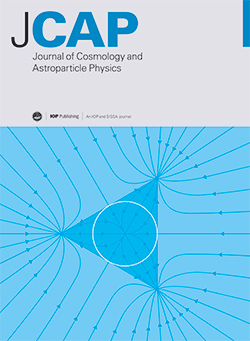Estimators for the cross-pairwise kSZ effect: forecasts for the dark energy and modified gravity parameters with Simons Observatory and CMB-S4
IF 5.3
2区 物理与天体物理
Q1 ASTRONOMY & ASTROPHYSICS
Journal of Cosmology and Astroparticle Physics
Pub Date : 2025-03-25
DOI:10.1088/1475-7516/2025/03/060
引用次数: 0
Abstract
We present and study a new cross-pairwise estimator to extract the kinetic Sunyaev Zeldovich (kSZ) signal from galaxy clusters. The existing pairwise kSZ method involves pairing clusters with other clusters and stacking them. In the cross-pairwise method, we propose to pair clusters with galaxies from a spectroscopic survey and then do the stacking. Cross-pairing decreases the measurement, instrumentation, and statistical noise, thus boosting the signal-to-noise ratio. However, we also need data from a galaxy survey in addition to the CMB temperature maps and a cluster catalog in order to use this method. We do a Fisher matrix analysis for the optimised pairwise and cross-pairwise estimators and forecast the ability of future Cosmic Microwave Background (CMB) experiments and galaxy surveys to measure cosmological parameters with the kSZ effect when combined with primary CMB and Baryon Acoustic Oscillation (BAO) data. We show that using the cross-pairwise kSZ estimator leads to a factor of 2(3) improvement in the 1σ error of the dark energy parameters w0 and wa and a factor of 4(6) improvement for the growth rate index γ compared to the pairwise estimator, when we pair the clusters from the Simons Observatory (CMB-S4) with the galaxies from the DESI survey.交叉两两kSZ效应的估计:利用Simons天文台和CMB-S4对暗能量和修正重力参数的预测
提出并研究了一种从星系团中提取动力学Sunyaev Zeldovich (kSZ)信号的交叉两两估计方法。现有的成对kSZ方法是将集群与其他集群配对并堆叠。在交叉配对方法中,我们建议将星系团与光谱调查中的星系配对,然后进行叠加。交叉配对降低了测量、仪器和统计噪声,从而提高了信噪比。然而,为了使用这种方法,除了CMB温度图和星团目录外,我们还需要来自星系调查的数据。我们对优化后的两两和交叉两两估计器进行了Fisher矩阵分析,并预测了未来宇宙微波背景(CMB)实验和星系调查结合原始CMB和重子声学振荡(BAO)数据,利用kSZ效应测量宇宙参数的能力。我们发现,当我们将来自西蒙斯天文台(CMB-S4)的星系团与来自DESI调查的星系配对时,使用交叉两两kSZ估计器导致暗能量参数w0和wa的1σ误差提高了2(3)倍,增长率指数γ提高了4(6)倍。
本文章由计算机程序翻译,如有差异,请以英文原文为准。
求助全文
约1分钟内获得全文
求助全文
来源期刊

Journal of Cosmology and Astroparticle Physics
地学天文-天文与天体物理
CiteScore
10.20
自引率
23.40%
发文量
632
审稿时长
1 months
期刊介绍:
Journal of Cosmology and Astroparticle Physics (JCAP) encompasses theoretical, observational and experimental areas as well as computation and simulation. The journal covers the latest developments in the theory of all fundamental interactions and their cosmological implications (e.g. M-theory and cosmology, brane cosmology). JCAP''s coverage also includes topics such as formation, dynamics and clustering of galaxies, pre-galactic star formation, x-ray astronomy, radio astronomy, gravitational lensing, active galactic nuclei, intergalactic and interstellar matter.
 求助内容:
求助内容: 应助结果提醒方式:
应助结果提醒方式:


